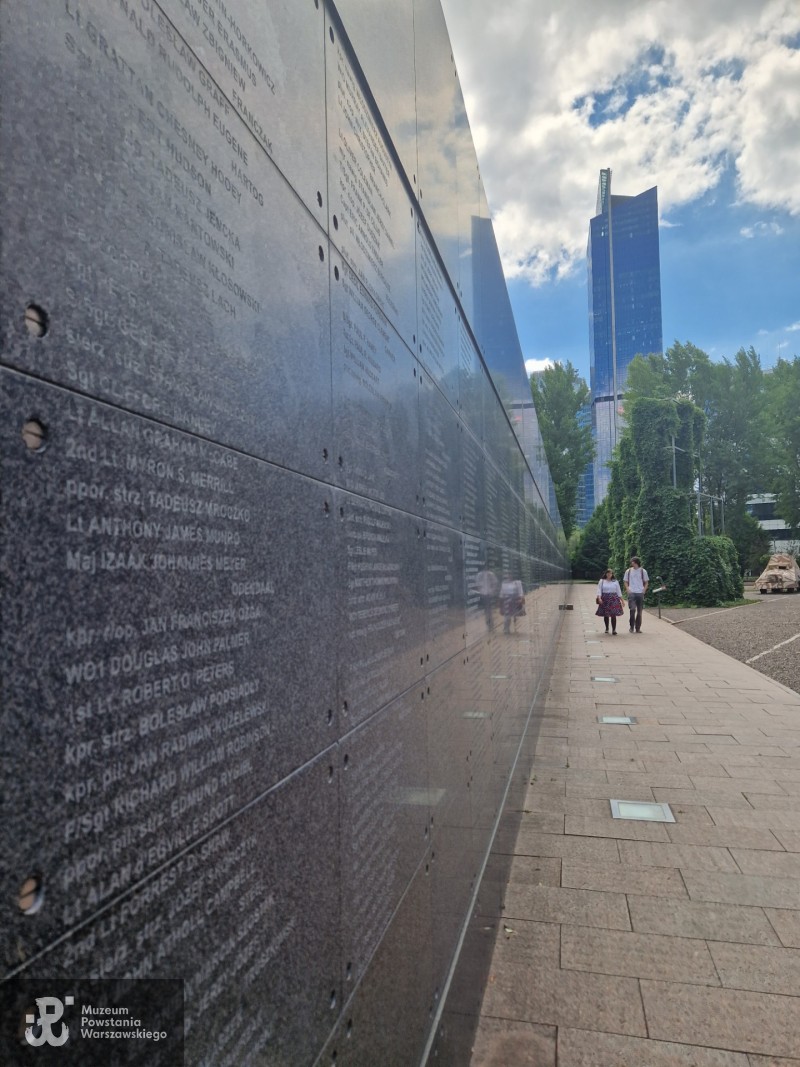



On 3 August 1944 the Allied command decided to send Liberators and Halifaxes over Warsaw to drop supplies to Poles fighting the deadliest urban battle in their history. These daring missions operated by RAF, SAAF and Polish 1586 Special Duty squadron meant that the airmen would be forced to fly 2,600 km at night over German occupied territory from the British airbase in Brindisi to Warsaw and back. Without stopping over. Up to 12 hours in the air with some airmen just managing to land back at Brindisi with empty fuel tanks. Many would never return. On 18 September 1944, 110 USAAF B-17s were sent from the UK airfields to Warsaw. However, the fate of Warsaw was almost sealed.
Sorties to Warsaw were initially operated only by the Polish 1586 Special Duty Flight. RAF No.148 Squadron assisted the mission but only towards different drop zones outside Warsaw. During the night of 12/13 August No. 148 Squadron flies direct to Warsaw for the first time alongside 1586. SAAF 31 Squadron and RAF No.178 Squadron join in from the night of 13/14 August. Later, due to losses, SAAF 34 Squadron was also assigned to those dangerous flights.
Bombardier Bryan Desmond Jones recalled the moment when the allied airmen learnt about their task, visibly moved still after years:
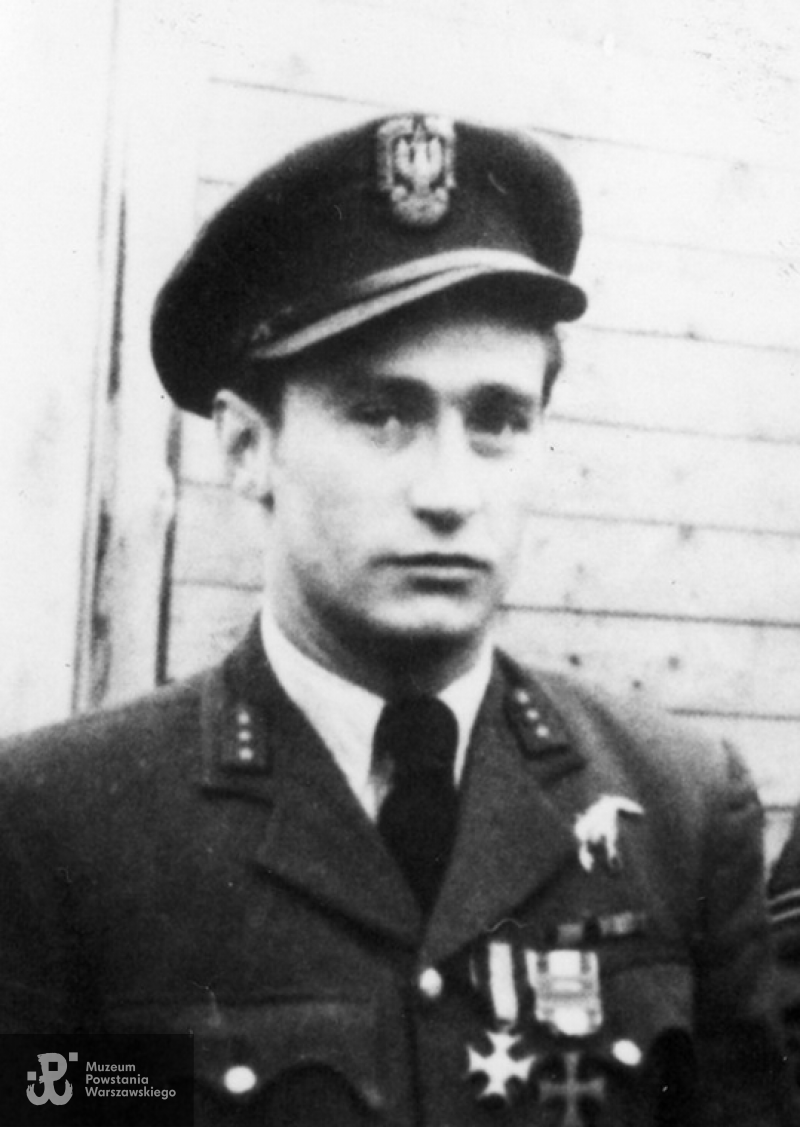
Photo: Cpt. Zbigniew Szostak, First pilot of Liberator KG 890, decorated twice with Virtuti Militari Cross, four times with the Cross of Valour and a Distinguished Flying Cross. Separated by war from his wife and son whom he would never see again. Source: public domain
Air Marshal Sir John Slessor reported that:
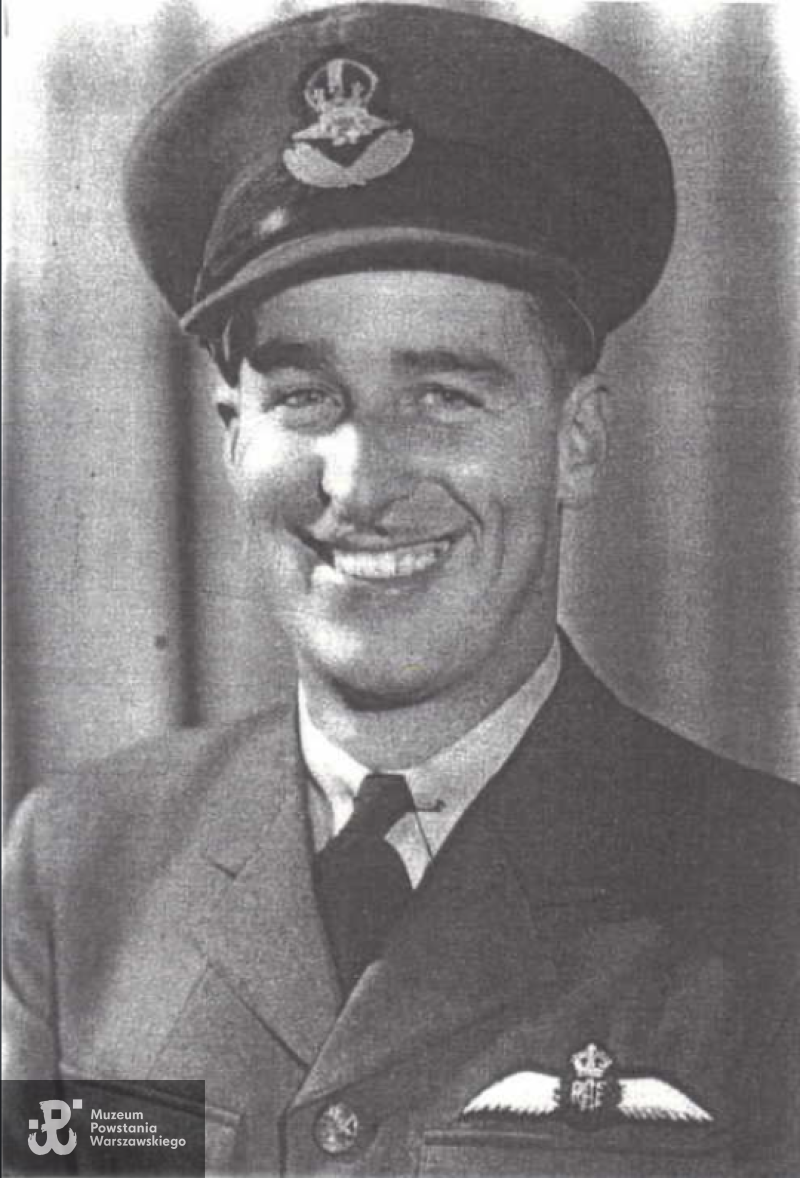
Photo: Flying Officer George Dougald MacRae, 178 RAF Sq. Royal Canadian Air Force, killed in action on 13 August 1944. His aircraft exploded over Skaryszewski Park in Warsaw. Air gunner Henry Lloyd Lyne was the sole survivor. Two days later G.D. MacRae’s brother, Jamie D. MacRae was KIA in the battle of Falaise. The losses for so many families were so hard to endure.
Since the outbreak of the Warsaw Rising, Franklin Delano Roosevelt struggled to convince Joseph Stalin to allow their aircraft to refuel at the Soviet occupied airfields. Americans wanted to reduce losses to their airmen. The weeks passed and Warsaw would become a heap of rubble.
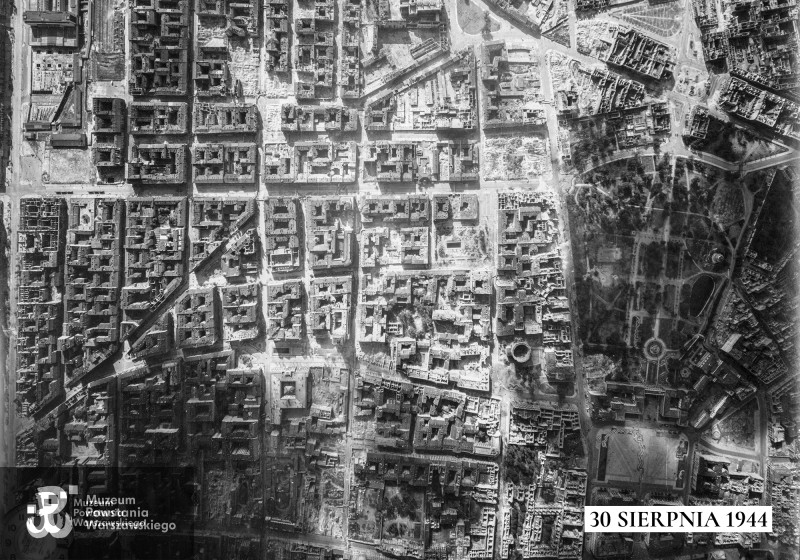
Photo: Aerial documentation of Warsaw’s city-centre on the 30th day of the Warsaw Rising. For more photographs visit https://korzeniemiasta.pl/en/home/.
The Russians accepted the American plan to supply Warsaw with weapons, ammo, food and medical aid finally in September. Frantic VII, an operation on a huge scale was launched. 107 B-17 reached Warsaw at noon on 18 September. However, as the bombers flew at 5,000 feet, out of 1,284 containers they dropped, it is believed that only 20% fell into the areas of Warsaw where Insurgents held their positions. Still, for the people of Warsaw it meant that we were not alone and any aid was like a ray of hope that maybe not everything was yet lost.
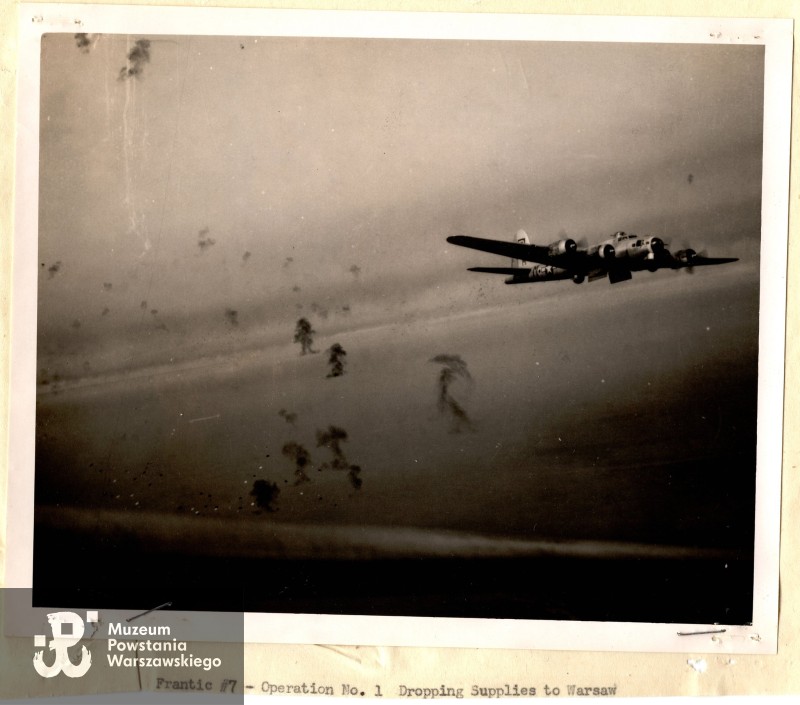
Photo: A B-17 bomber dropping supplies over Warsaw. FRANTIC VII. 18 September 1944
For Polish and Commonwealth airmen who flew at night from Southern Italy to Warsaw each sortie brought more and more casualties. On 14 September 1944 Władysław Raczkiewicz, the Polish President, wrote a telegram to South-African Field-Marshal Jan Smuts: “I have just received (…) a detailed report of the heavy losses suffered by the South African Squadron No.31 in their gallant attempt to help our fighting capital. The epic flights will not be forgotten by the Polish people for many years to come.” J. Smuts replied that “we are proud to have stood by Warsaw in her hour of ordeal.”
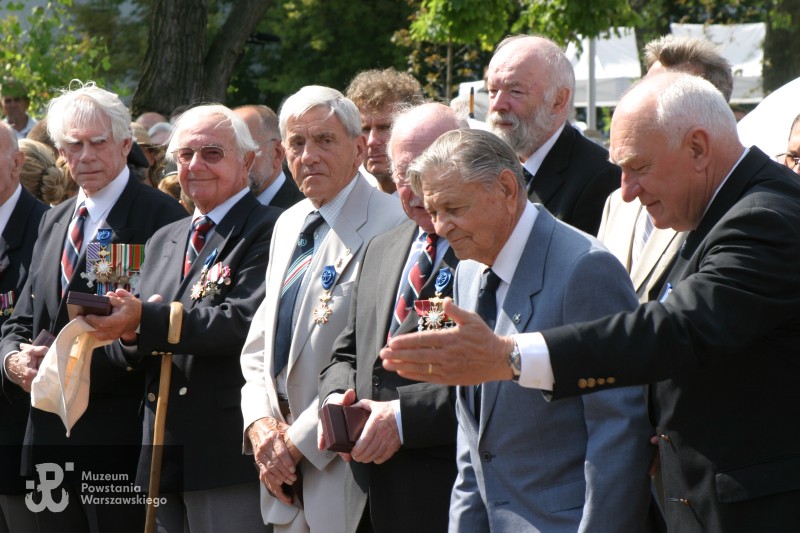
Photo: SAAF pilot Dirk Nel used to say that Warsaw Airlift was “mission impossible”. He was decorated by Lech Kaczyński, the President of the Republic of Poland in 2006. Standing (from the left): George Robert Adams, William Hayden Jones, David Patison Lambert, Douglas Frederick Matthews and Dirk Nel.
The view of Warsaw in flames from above would never leave those who saw Polish people during their time of the utmost trial. In 1980’s some former airmen were reunited for the first time in decades when being awarded the Warsaw Uprising Cross. They decided to stay in touch. First, they formed the 'Warsaw '44 Club' and later the 'Air Bridge Association'. They issued an annual newsletter for years and would regularly meet and keep the bonds of friendship alive, both in Poland and overseas. Now, the archives of the ‘Warsaw’44 Club’ and the ‘Air Bridge Association’ can be found in the Archive of the Warsaw Rising Museum.
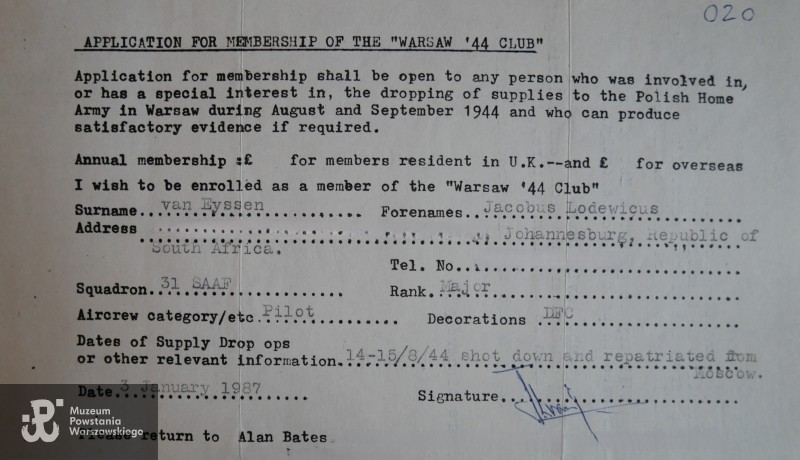
Photo: Application for membership of “Warsaw’44 Club”. Cpt. Jack Van Eyssen was one of the five survivors of SAAF Liberator KG-939 that crashed in Michalin near Warsaw on 15 August 1944.
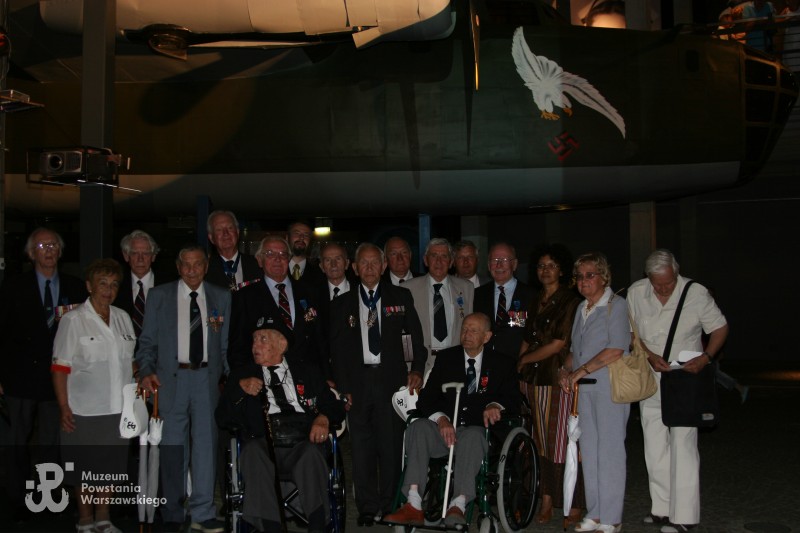
Photo: Veterans of the Warsaw Airlift. South-African, British and Polish crew members reunited after the years. Under 1:1 replica of a B-24 liberator. Warsaw Rising Museum, 2006.
These brave airmen are forever in our memory. Their courage and dedication to the cause will be always remembered. In Poland we try to uphold the memory of those who did not leave us alone then when Warsaw was in need of air supplies. There are many memorials in Poland where every year official commemorations are being held and still new are being unveiled. 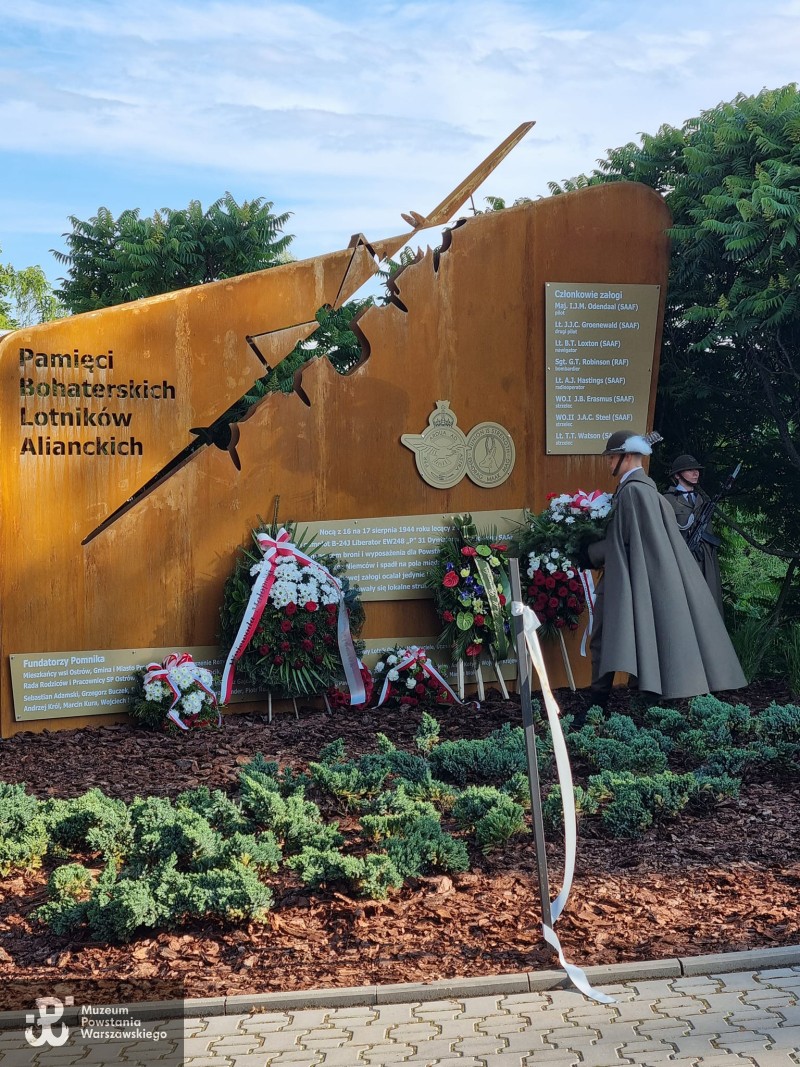
Photo: A new monument dedicated to the crewmembers of SAAF Liberator EW 248P was unveiled in Ostrów near Cracow in June 2024.
In the Warsaw Airbridge, also referred to as Warsaw Concerto, 112 Polish, 90 British, 43 South-African and 12 American airmen sacrificed their lives.
The Warsaw Rising lasted from 1 August to 2 October 1944. Up to 180,000 people are said to be killed. Additionally, 650,000 inhabitants of Warsaw were expelled from their homes, relocated or deported into the Unknown – to the concentration camps or forced labour. A city of 900,000 inhabitants ceased to exist. The Soviet Red Army stood on the right river bank of the Vistula river and watched peacefully the spectacle of Warsaw in flames. The Soviets decided to intervene on 17 January 1945 when the capital of Poland was already a sea of ruins with no sign of life. Their plan worked well. The night of communism would fall over Poland for long 44 years till 1989.
The list of the Allied airmen who perished at the time of the Warsaw Rising whose names are engraved in the Memorial Wall that stands in the Freedom Park in Warsaw:
1st Lt. FRANCIS E. AKINS
Capt LEONARD CHARLES ALLEN
Lt PETER HERBERT ANDREWS
2nd Lt. CLYDE ALISON ARRANTS
kpr.nawig. WŁODZIMIERZ AUGUSTYN
plut.mech.pokł. WILHELM ANDRZEJ J. BALCAREK
Sgt FERNARD JOSEPH BARRETT
W/O MURRAY ALEXANDER BAXTER
F/O ELY BERENSON
plut.pil. JÓZEF BIELICKI
plut.r/op.strz. STEFAN BOHANES
F/O ALBERT MILVRON BONNEY
W/O EDWARD BRADSHAW
Lt JOHN CHRISTOPHER BRANCH-CLARK
WO1 DOUW B. BRANDSMA
WO II HERBERT JAMES BROWN
Lt OLIVER COLEMAN
Lt CEDRICK ARTHUR COOKE
Lt PERCY GORDON COUTTS
mjr.nawig. STANISŁAW JERZY DANIEL
F/Sgt ROBERT SAMUEL DARLING
Sgt SYDNEY JOHN DAVIS
T/Sgt. FRANK P. DE CILLIS
F/O RONALD GEORGE DEVINE
plut.bomb. TADEUSZ DUBOWSKI
kpr.r/op. JÓZEF DUDZIAK
ppor.bomb. KONSTANTY DUNIN-HORKOWICZ
kpr.strz. FRANCISZEK DZIADUŁA
Capt ERIC ARNOLD ENDLER
WO1 JACOBUS BURGER ERASMUS
Lt KEITH FAIRWEATHER
plut.pil. WŁODZIMIERZ SERGIUSZ FEDZIŃSKI
plut.strz. JAN FLORKOWSKI
ppor.pil. MIECZYSŁAW WITOLD FOCZPANIAK
Sgt CECIL EDWARD FOREMAN
ppor.pil. STANISŁAW ZBIGNIEW FRANCZAK
Sgt EDWARD GEORGE FRETWELL
Sgt WILLIAM GEORGE CLEMENT GARNER
plut.pil. BOLESŁAW GRAFF
2/Lt ROBERT GEORGE HAMILTON
S/Sgt. PAUL F. HANEY
Sgt RONALD RUDOLPH EUGENE HARTOG
Lt ARTHUR JAMES HASTINGS
1st Lt. PAUL R. HIBBARD
Lt GRATTAN CHESNEY HOOEY
Sgt SIDNEY FRANK HORNE
Sgt WILLIAM HUDDART
Sgt HERBERT HUDSON
Lt ERIC BEN HORTON IMPEY
por.nawig. BOLESŁAW ANTONI S. JASIŃSKI
por.nawig. TADEUSZ JENCKA
kpr.strz. EDWARD JODIS
Sgt GORDON WALLACE JOSLYN
kpr.bomb. JAN KANTOWSKI
ppor.nawig. STEFAN GABRIEL KLENIEWSKI
Lt WALTER KLOKOW
kpr.strz. BRONISŁAW KŁOSOWSKI
ppor.bomb. WŁADYSŁAW KOZIOŁ
ppor.bomb. ZBIGNIEW JERZY KOZŁOWSKI
ppor.nawig. TADEUSZ LACH
Lt RAY ARRAS LAVERY
Sgt THOMAS LAW
Capt GORDON LAWRIE
Lt RALPH LAURENCE LAWSON
W/O JASPER VICTOR LEE
Sgt PETER HENRY GEORGE LEES
Lt HERBERT HENRY LEWIS
Lt BERNARD THOMAS LOXTON
S/Sgt. GEORGE A. MacPHEE
F/O GEORGE DOUGALD MacRAE
plut.strz. RUDOLF MAJEWSKI
sierż.strz. STANISŁAW MALCZYK
Lt HARRY ALLPRESS RUSTON MALE
sierż.pil. BRUNON MALEJKA
Sgt CLIFFORD MANLEY
plut.mech.pokł. JAN ZDZISŁAW MARECKI
Sgt LESLIE MAYES
Lt ALLAN GRAHAM McCABE
Lt ALLAN JOHN McINNES
F/Sgt HUGH VALANCE McLANACHAN
2nd Lt. MYRON S. MERRILL
WO II JOSEPH ARNOLD MEYER
Sgt MATTHEW THOMAS MOUNTAIN
ppor.strz. TADEUSZ MROCZKO
plut.mech.pokł. STANISŁAW JÓZEF MUCHA
ppor.strz. ADAM MÜHLN
Lt ANTHONY JAMES MUNRO
Sgt JOHN RICHARD WILLIAM NICKERSON
Maj IZAAK JOHANNES MEYER ODENDAAL
kpr.strz. TADEUSZ OGRODNIK
WO1 TERENCE DESMOND O'KEEFE
kpt.nawig. FRANCISZEK KAZIMIERZ OMYLAK
kpr.r/op. JAN FRANCISZEK OŻGA
W/O ERNEST HENRY JOHN PAGE
F/Sgt ROLAND CHARLES PAIN
WO1 DOUGLAS JOHN PALMER
kpr.strz. JAN PASZKIEWICZ
plut.r/op. WITOLD PAŹDZIOR
1st Lt. ROBERT O. PETERS
Lt GORDON BRUCE PITT
kpt.pil. ZYGMUNT PLUTA
kpr.strz. BOLESŁAW PODSIADŁY
Sgt JOHN EDWARD PORTER
Sgt WILLIAM PRATT
kpr.pil. JAN RADWAN-KUŻELEWSKI
Capt NICOLAAS VAN RENSBURG
Sgt GERARD THOMAS ROBINSON
F/Sgt RICHARD WILLIAM ROBINSON
Sgt PETER HENRY ROOTS
plut.mech.pokł. WINCENTY TADEUSZ RUTKOWSKI
ppor.pil.strz. EDMUND RYGIEL
Sgt RICHARD HERBERT CHARLES SCOTT
Sgt ARTHUR SHARPE
2nd Lt FORREST D. SHAW
S/Sgt. WALTER P. SHIMSHOCK
sierż.strz. ROMAN JAKUB SIKORSKI
st.sierż.strz. JÓZEF SKORCZYK
por.bomb. KAZIMIERZ SORÓWKA
WO1 REGINALD WALTER STAFFORD
WO II JOHN ATHOLL CAMPBELL STEEL
Lt TIMOTHY A. STEWART
Sgt RUPERT VINCENT STONIER
Lt ALAN d'EGVILLE SCOTT
Sgt GEORGE SWIFT
kpr.mech.pokł. ALFRED JAN SZMIGIELSKI
kpt.pil. ZBIGNIEW MARCIN SZOSTAK
plut.mech.pokł. ANTONI JAN SZYLLER
F/Lt EDWIN CHARLES THYER
st.sierż.strz.r/op. JERZY JÓZEF TRUSZKOWSKI
Sgt EDWARD HALL TURNER
1st Lt. JOSEPH J. VIGNA
kpr.r/op. KAROL WAŁASZEK
kpr.r/op. LUDWIK WANTULOK
Lt THOMAS TENNANT WATSON
sierż.strz. BOLESŁAW WAWRZAK
plut.pil. BERNARD WEBER
sierż.r/op. EDWARD WEINZ
plut.bomb. BERNARD WICHROWSKI
ppor.pil. KAZIMIERZ WIDACKI
Sgt JOHN WINTER
sierż.r/op.strz. JÓZEF WITEK
sierż.mech.pokł. LEON ZYGMUNT WITKOWSKI
WO II BEN NEVIS WOODS
plut.pil. JÓZEF HENRYK WOROCH
por.nawig. LUCJAN PIOTR WOYTANOWICZ
F/Sgt RONALD ZAMBRA
plut.mech.pokł. EDMUND ZIELIŃSKI
